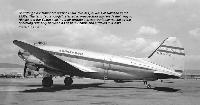Фотографии
-
Регистрационный номер: N4877V Weary C-46 N4877V of Capitol Airways, one of the lucky companies to survive the CAB’s regular “shakeouts”. Scheduled airline Capital Airlines bitterly opposed such a similar name, but the non-sked had begun operations while Capital was still trading as Pennsylvania Central Airlines.
Самолёты на фотографии: Curtiss-Wright C-46 / CW-20 Commando - США - 1940
-
Регистрационный номер: CF-IHU, N1683M New Jersey-based Coastal Cargo operated passenger services as Coastal Air Coach; this C-46, N1683M (c/n 22476, originally built as 44-78653) served with the airline throughout the early 1950s. By 1955 it had moved to Canada, where it was registered as CF-IHU and operated by Dorval Air Transport. It ended its days in Bolivia.
Самолёты на фотографии: Curtiss-Wright C-46 / CW-20 Commando - США - 1940
-
Регистрационный номер: N3935C Modern Air Transport, also based in New Jersey, was another of the lucky carriers to survive the CAB’s machinations to “rationalise” the non-skeds. By the 1970s Modern Air Transport had overcome all the obstacles thrown in the way of the non-skeds and was operating a fleet of sleek Convair CV-990A Coronado jetliners.
Самолёты на фотографии: Curtiss-Wright C-46 / CW-20 Commando - США - 1940
-
Регистрационный номер: N67970 Slick Airways C-46 N67970 (c/n 22587) at San Francisco. Founded by Earl J. Slick in 1946, the company concentrated on cargo charters, but suffered from a poor initial safety record, which included five C-46 crashes between 1947 and 1949.
Самолёты на фотографии: Curtiss-Wright C-46 / CW-20 Commando - США - 1940
-
Регистрационный номер: N95451 Sourdough Air Transport Curtiss C-46F (c/n 441) N95451 at Oakland in the 1950s. The term “sourdough” referred to prospectors who made their way to Alaska and the Yukon seeking their fortune, the appropriately-named airline operating primarily between its base in Seattle and airfields in Alaska.
Самолёты на фотографии: Curtiss-Wright C-46 / CW-20 Commando - США - 1940
-
Large irregular carriers proliferated during the late 1940s, one such example being the Reverend Chris Bachman’s 20th Century Airlines, based in Charlotte, North Carolina, which operated a fleet of DC-3s, one of which is seen here operating a charter flight to Miami in 1947.
Самолёты на фотографии: Douglas DC-3 / C-47 Skytrain/С-53 Skytrooper / Dakota - США - 1935
-
Регистрационный номер: N37474 Success for the non-skeds often depended on military contracts. This California Eastern Airways Douglas DC-4, N37474, photographed at Oakland in 1955, proudly declares its commitment to the US Navy.
Самолёты на фотографии: Douglas DC-4 / C-54 / R5D Skymaster - США - 1942
-
One of the most successful large irregular carriers was Transocean Airlines (TALOA), which at its peak boasted some 6,700 employees at 57 bases worldwide. It was the inspiration for the fictional carrier TOPAC featured in Ernest K. Gann’s novel The High and the Mighty, made into a film starring John Wayne and a TALOA DC-4 in 1954.
Самолёты на фотографии: Douglas DC-4 / C-54 / R5D Skymaster - США - 1942
-
Регистрационный номер: N6575C One of the few that prospered; while most of the large irregular carriers - or “non-skeds” - relied on secondhand aircraft and failed to survive the Civil Aeronautics Board’s scrutiny, some fought back and thrived. Some even managed to acquire modern equipment in the 1950s, including Irving E. Herman’s Great Lakes Airlines, which operated Douglas DC-6A N6575C, seen here at Oakland, California.
Самолёты на фотографии: Douglas DC-6 / C-118 Liftmaster - США - 1946
Статьи
- -
- A.Griffith - America's Ramjagers
- A.Roberts - Death of a Visionary: Edward T. Busk and "Stability Jane"
- A.Zeitler - "we wanted to do somethind challenging..."
- B.Archer - Party Time!
- D.Stringer - Non-Skeds! /The Story of America's Supplemental Airlines/ (1)
- F.Merriam - Up for the Cup! /Echoes from Dawn Skies/ (4)
- G.Alegi - Alitalia's Fab Four
- J.Forsgren - Holf the Front Page! The ASJA Viking
- J.Franzi - Perfect Third? /An eye for detail/
- J.Watson - "It was a Jaguar D-type on steroids"
- P.Davidson - Off the Beaten Track...
- P.Jarrett - Lost & Found
- P.Vabre - Lost without trace?
- R.Gardner - A Jaunt Over Germany
- R.Pegram - Folland's Forgotten Monoplanes (1)








